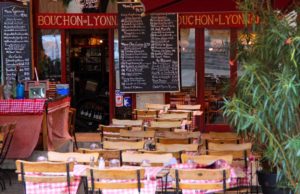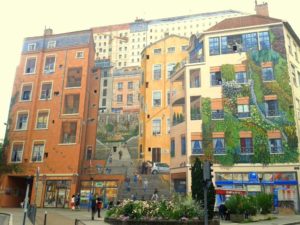Lyon has had many accolades over the years from being the historic European centre of silk, the ancient capital of the Gauls to the birthplace of cinema and more recently the world capital of gastronomy, Lyon seems to have it all. It is after-all, heralded as France’s second city – after Paris – and as it is built on the banks of two rivers and between two hills, the bridge-hopping, hill climbing experience adds a new dimension to the way you explore a city that was once an industrial hub.
The city offers a blend of old architecture and new cuisine, of traditional crafts and avant-garde art that is likely to appeal to even the most exigent traveller.
Must see the view

A stroll up the Fourvière hill, which rises abruptly behind the old town, will take you to the Notre Dame de Fourvière church and the site of Lyon’s oldest Roman settlement. You can get there more quickly by jumping on the cable car. The locals call it the “ficelle” (the rope), which will pull you up the slope in just five-minutes. From the hilltop esplanade in front of the church you can see all of Lyon and beyond.
The concrete landscape is cut by veins of water from the two traversing rivers, the Rhône and the Saône. This Fourvière hill has been dubbed “the hill that prays” as it is the location of a church where the priests would stay and became the symbol of the power of the Catholic Church. From here look to the left and you will see “hill that works” in the Croix-Rousse weavers’ historic neighbourhood. This is where the working class lived and worked predominantly as silk weavers.
Must Visit
The Maison des Canuts, Lyon’s silk museum, is hidden on a narrow street in the weavers’ old neighbourhood, Croix-Rousse. Set in a modest 19th century weaver’s house, you could easily miss its small entrance. But then you’d miss a historic gem that exhibits Lyon’s tradition of silk production extending over five centuries. The stories about the silk weavers’ harsh lives will take you back in history when Lyon was the capital of the European silk trade. You’ll see a demonstration of how silk is woven following the patterns on a paper model, and you’ll get the chance to run your fingers on silk fabrics valued at thousands of euros per metre.
Must Eat

When the food critic Curnonsky called Lyon “the world capital of gastronomy” in 1935, all lovers of fine French cuisine flocked to the city. And there’s no better place to savour the flavors of this region than at a bouchon. A typical Lyonnaise family-owned bistro, it serves hearty homemade dishes, just like silk weavers used to eat a century or two ago. Getting a table at a bouchon is like stepping back in time. The big-bellied waiter shouting a lively bonjour will probably seat you at a table with red-and-white checkered tablecloth, and century-old decorations on the walls. He may suggest traditional dishes like quenelles, a sort of mixed fish with cream sauce, smoked pork sausage or “silk-weaver’s brain”, a type of herb cheese. You’ll want to sample them all when your nostrils fill with the mixed aromas escaping from the kitchen.
Must Explore

Lyon’s 13 mural paintings dotted throughout the city make up a contemporary open-air gallery. As you roam the cobblestone streets and pedestrian plazas, you’ll see huge paintings with optical illusions decorating building walls that somehow pull you right in. One of the most popular is the Fresque des Lyonnais, on the Quai St. Vincent. Thirty of Lyon’s legendary residents are depicted from the writer Antoine de Saint-Exupery to the Lumière brothers, the first filmmakers in history. Another mural, defining the city’s character is the Mur des Canuts. Dedicated to the 19th century silk weavers that lived in this area, this is the biggest mural in Europe.





thats amazing place
ReplyDelete